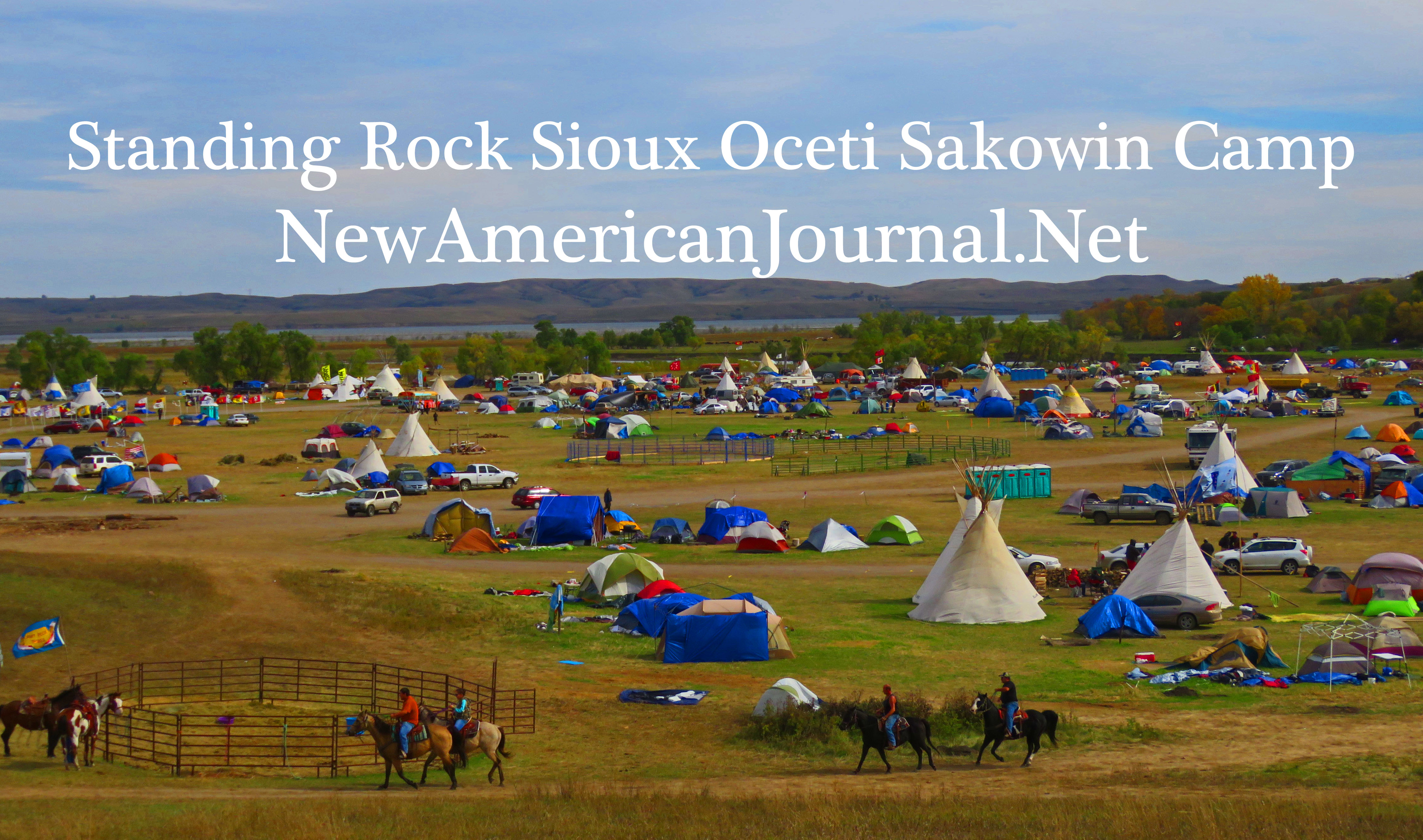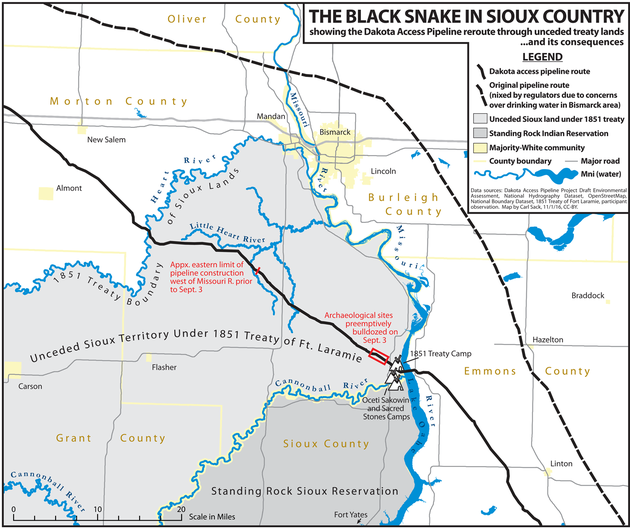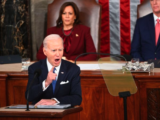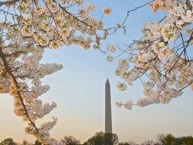The Big Picture –
By Glynn Wilson –
What is the Obama administration waiting for? It is time to call up the National Guard and deploy it to Standing Rock to protect the water protectors.
At the height of the civil rights struggles in Alabama during the tumultuous 1960s, President Johnson was waiting on the right moment to put forward the Voting Rights Act in Congress. According to Bill Moyers, Johnson’s press secretary, other written histories and the movie Selma, Johnson was on record “urging King to do something to arouse the sleeping white conscience.”
When the marchers in Selma were beaten with billy clubs and sprayed with tear gas by Dallas County Sheriff’s Department deputies and Alabama State Troopers on orders of Governor George C. Wallace while trying to cross the Edmund Pettus Bridge on the way to Montgomery, the incident on the day that came to be called Bloody Sunday, Johnson “knew the moment had come,” Moyers says. “He told me to alert the speechwriters to get ready and within days he made his own famous ‘We Shall Overcome’ address that transformed the political environment.”
He also called up the National Guard to protect the marchers from local and state police, and as a result, the next march made it all the way from Selma to Montgomery.
What is the Obama administration waiting for? If not now, when? The president has the power of the pen to halt the construction of this pipeline, just as he did the Keystone XL pipeline last year.
On the night of November 20, 2016, in sub-freezing temperatures, the Dakota Access Pipeline company in North Dakota was preparing to start work on the final section of the oil pipeline under Lake Oahe, a reservoir on the Mississouri River along the border of the Standing Rock Sioux Reservation on land controlled by the U.S. Army Corps of Engineers. So some of the “Water Protectors” tried to move a barricade of burnt vehicles cops had erected to keep them away from the pipeline construction site. When protesters activated and tried to get in the way, the cops opened fire with rubber bullets, water cannon fire, tear gas canisters, and apparently pepper spray and/or mace to try to disperse the crowd of about 400.
The live Facebook video captured by an amateur with a smart phone went on for hours, and was watched by more than 8 million people.
Dakota Access Pipeline Protesters Clash With Cops on Blackwater Bridge
If this is not the environmental movement’s Bloody Sunday in the name of protecting the planet from climate change due to global warming from the burning of fossil fuels, maybe what happens on Monday, December 5, will be the day — if the Morton County Sheriff’s Department tries to enforce the Corps evacuation order and the governor’s emergency eviction notice.
A group of U.S. military veterans that could top 2,000 has already begun arriving at the Oceti Camp north of Cannon Ball, and they are vowing to act as a “human shield” to protect the water protectors from the wrath of local cops and private security forces hell bent on getting them out of the way so construction of the extension pipeline between North Dakota and Iowa can be completed in time to meet the deadline on a critical contract that expires in January.
Veterans Group Plans ‘Deployment’ to Join Dakota Access Pipeline Protest
In defiance of an evacuation order to close down the camp from the U.S. Army Corps of Engineers and an emergency eviction notice from the Republican Governor of North Dakota, and even the advice of some tribal elders who advise a tactical retreat back to the reservation south of the Cannonball River, some leading activists are vowing to stay and pray. The tribe says “the best way to protect people during the winter, and reduce the risk of conflict between water protecters and militarized police, is to deny the easement for the Oahu crossing…”
Standing Rock Pipeline Protestors Vow to Defy Eviction Order and Remain Camped on Public Land
In light of events at Standing Rock and the concerns about the integrity of water, it might be wise to consider the announcement by President Obama in 2010 regarding the “Protection of Native American Lands and the Environment, and Redress.” In December 2010, the Obama administration issued a statement of support for the United Nations Declaration on the Rights of Indigenous Peoples that was adopted by the UN in 2007.
Consider this excerpt from the “Annex” of the 2007 UN Declaration followed by excepts from Obama’s statement that includes his section on “Protection of Native American Lands and the Environment, and Redress.”
Guided by the purposes and principles of the Charter of the United Nations, and good faith in the fulfillment of the obligations assumed by States in accordance with the Charter,
Affirming that indigenous peoples are equal to all other peoples, while recognizing the right of all peoples to be different, to consider themselves different, and to be respected as such,
Affirming also that all peoples contribute to the diversity and richness of civilizations and cultures, which constitute the common heritage of humankind,
Affirming further that all doctrines, policies and practices based on or advocating superiority of peoples or individuals on the basis of national origin or racial, religious, ethnic or cultural differences are racist, scientifically false, legally invalid, morally condemnable and socially unjust,
Reaffirming that indigenous peoples, in the exercise of their rights, should be free from discrimination of any kind…
Then, consider this from the Obama administration’s announcement of U.S. Support for the United Nations Declaration on the Rights of Indigenous Peoples, subtitled Initiatives to Promote the Government-to-Government Relationship and Improve the Lives of Indigenous Peoples.
I. Introduction
In his Presidential Proclamation last month honoring National Native American Heritage Month, President Obama recommitted to supporting tribal self-determination, security and prosperity for all Native Americans. He recognized that while we cannot erase the scourges or broken promises of our past, we will move ahead together in writing a new, brighter chapter in our joint history.
It is in this spirit that the United States today proudly lends its support to the United Nations Declaration on the Rights of Indigenous Peoples (Declaration). In September 2007, at the United Nations, 143 countries voted in favor of the Declaration. The United States did not.
Today, in response to the many calls from Native Americans throughout this country and in order to further U.S. policy on indigenous issues, President Obama announced that the United States has changed its position. The United States supports the Declaration, which-while not legally binding or a statement of current international law-has both moral and political force. It expresses both the aspirations of indigenous peoples around the world and those of States in seeking to improve their relations with indigenous peoples. Most importantly, it expresses aspirations of the United States, aspirations that this country seeks to achieve within the structure of the U.S. Constitution, laws, and international obligations, while also seeking, where appropriate, to improve our laws and policies.
U.S. support for the Declaration goes hand in hand with the U.S. commitment to address the consequences of a history in which, as President Obama recognized, few have been more marginalized and ignored by Washington for as long as Native Americans — our First Americans. That commitment is reflected in the many policies and programs that are being implemented by U.S. agencies in response to concerns raised by Native Americans, including poverty, unemployment, environmental degradation, health care gaps, violent crime, and discrimination.
II. The Review of the U.S. Position on the Declaration
The decision to review the U.S. position on the Declaration came in response to calls from many tribes, individual Native Americans, civil society, and others in the United States, who believed that U.S. support for the Declaration would make an important contribution to U.S. policy and practice with respect to Native American issues. The decision by the United States to support the Declaration was the result of a thorough review of the Declaration by the relevant federal agencies.
In conducting its review of the Declaration, U.S. agencies consulted extensively with tribal leaders during three rounds of consultations, one in Rapid City, South Dakota, and two in Washington, D.C. In addition, the agencies conducted outreach to indigenous organizations, civil society, and other interested individuals. Tribal leaders and others contributed to the review through their attendance at the consultation and outreach sessions, participation in those sessions by means of conference calls, and written submissions. In total, over 3,000 written comments were received and reviewed.
Tribes, groups, and individuals who participated in the review of the U.S. position on the Declaration presented a wide range of views on the meaning and importance of the Declaration. While they could not all be directly reflected in the U.S. position on the Declaration, they were all considered in the process.
III. 2 Protection of Native American Lands and the Environment, and Redress
The United States recognizes that some of the most grievous acts committed by the United States and many other States against indigenous peoples were with regard to their lands, territories, and natural resources. For this reason, the United States has taken many steps to ensure the protection of Native American lands and natural resources, and to provide redress where appropriate. It is also for this reason that the United States stresses the importance of the lands, territories, resources and redress provisions of the Declaration in calling on all States to recognize the rights of indigenous peoples to their lands, territories, and natural resources. Consistent with its understanding of the intention of the States that negotiated and adopted the Declaration, the United States understands these provisions to call for the existence of national laws and mechanisms for the full legal recognition of the lands, territories, and natural resources indigenous peoples currently possess by reason of traditional ownership, occupation, or use as well as those that they have otherwise acquired. The Declaration further calls upon States to recognize, as appropriate, additional interests of indigenous peoples in traditional lands, territories, and natural resources.
Consistent with that understanding, the United States intends to continue to work so that the laws and mechanisms it has put in place to recognize existing, and accommodate the acquisition of additional, land, territory, and natural resource rights under U.S. law function properly and to facilitate, as appropriate, access by indigenous peoples to the traditional lands, territories and natural resources in which they have an interest.
U.S. agency initiatives in this area are numerous.
Perhaps most significantly, the Obama Administration has acquired over 34,000 acres of land in trust on behalf of Indian tribes, which is a 225 percent increase since 2006. Lands held in trust for tribes are used for housing, economic development, government services, cultural and natural resource protection, and other critical purposes. Recovering and protecting the tribes’ land base is a hallmark objective of this Administration. After the recent Supreme Court decision in Carcieri v. Salazar, Congress introduced, and the Administration has fully supported, legislation to reaffirm the authority of the United States to take land into trust on behalf of all federally recognized Indian tribes.
In addition, the United States intervened in a federal suit, Saginaw Chippewa Indian Tribe of Michigan and United States v. Granholm, and worked to facilitate a settlement that recognizes the tribe’s entire reservation to be Indian Country, resolving over a century of disputes over the boundaries and existence of the reservation. The court approved that settlement on November 23, 2010. This settlement, which involves the tribe, the United States, the State of Michigan, and local governments, will promote greater intergovernmental cooperation and provide the clarity necessary for effective law enforcement and civil regulation on the reservation. The United States has also sought to protect tribal lands, and tribal jurisdiction over those lands, in several other court cases, including the City of Sherrill v. Oneida Indian Nation, Cayuga Nation v. Gould, and Water Wheel v. LaRance.
Other agency initiatives include the release by the Forest Service of $37.3 million in Recovery Act funds directly to tribes for wild land fire management and the improvement of habitat and watersheds. Of the total Forest Service funding received under the Recovery Act, $213 million was provided to benefit tribes and tribal lands.
The Obama Administration has also made extensive efforts to resolve longstanding Native American legal claims against the United States and private entities related to lands, natural resources, and other issues.
In 2009, the United States reached an agreement for over $1.79 billion to address contamination at over 80 sites in 19 states pursuant to resolution of the American Smelting and Refining Company, LLC (ASARCO) bankruptcy. The settlement includes approximately $194 million for the recovery of wildlife, habitat, and other natural resources managed by the federal, state, and tribal governments at more than a dozen sites. The settlement is part of the largest environmental damage bankruptcy case in U.S. history, and resolves ASARCO’s environmental liabilities from mining and smelting operations that contaminated land, water, and wildlife resources on federal, state, tribal, and private land.
In late October 2010, the Administration reached a $760 million settlement with Native American farmers and ranchers, in Keepseagle v. Vilsack, a case alleging discrimination by the Department of Agriculture in loan programs. Under the agreement, the Department of Agriculture will pay $680 million in damages and forgive $80 million of outstanding farm loan debt. The federal government also agreed to create a 15-member Native American Farmer and Rancher Council to advise the Department, appoint a Department ombudsman, provide more technical assistance to Native American borrowers, and conduct a systematic review of farm loan program rules.
On December 9, 2010, President Obama signed into law the Claims Resolution Act, which includes the Cobell v. Salazar settlement agreement. In 1996, Elouise Cobell charged the Department of the Interior with failing to account for billions of dollars that it was supposed to collect on behalf of more than 300,000 individual Native Americans. After fourteen years of litigation, enactment of the Claims Resolution Act finally closes an unfortunate chapter in our history. The Act creates a fund of $1.5 billion dollars to address historic accounting and trust management issues, and it also allocates up to $1.9 billion dollars to convert some of the most highly fractionated individual Indian lands into land that can be managed for the broader benefit of the respective tribe. As part of the $1.9 billion, a trust fund of up to $60 million dollars is being created for a scholarship fund for Native Americans.
In addition, this law includes an unprecedented package of four water settlements benefiting seven tribes in Arizona, Montana, and New Mexico. This law finally gives the Crow, White Mountain Apache Tribe, and the Pueblos of Taos, Tesuque, Nambe, Pojoaque, and San Ildefonso permanent access to secure water supplies year round.
As noted by Secretary of the Interior Salazar, Congress’ approval of the Cobell settlement and the four Indian water rights settlements is nothing short of historic for Indian nations. He explained that the settlements represent a major step forward in President Obama’s agenda to empower tribal governments, fulfill our trust responsibilities to tribal members and help tribal leaders build safer, stronger, healthier and more prosperous communities. They demonstrate not only that the United States has a well-developed court system that provides a means of redress for many wrongs suffered by U.S. citizens, residents and others – including federally recognized tribes and indigenous individuals and groups — but also that redress is available from the U.S. Congress under appropriate circumstances. The United States will interpret the redress provisions of the Declaration to be consistent with the existing system for legal redress in the United States, while working to ensure that appropriate redress is in fact provided under U.S. law.
The Administration is likewise committed to protecting the environment, and recognizes that many indigenous peoples depend upon a healthy environment for subsistence fishing, hunting and gathering. The Administration therefore acknowledges the importance of the provisions of the Declaration that address environmental issues. While there is far more that needs to be done, the United States is taking many steps to address environmental challenges in Indian Country and beyond.
In July 2010, President Obama signed Executive Order 13547, Stewardship of the Ocean, our Coasts, and the Great Lakes, drafted with substantial input from tribes, which established a Governance Coordination Committee with three tribal representatives, as well as tribal engagement in developing priority action areas. Of special interest are the priority areas of the Arctic and developing coastal and marine spatial plans.
In 2010, the Department of the Interior (DOI) provided grants worth more than $7 million through the Tribal Wildlife Grants Program for 42 Native American tribes to fund a wide range of conservation projects in sixteen states. The Tribal Wildlife Grants program has provided more than $50 million in the past eight years for 400 conservation projects administered by 162 federally-recognized tribes. The grants provide technical and financial assistance for the development and implementation of projects that benefit fish and wildlife resources and their habitat, including non-game species.
DOI has also engaged in numerous cooperative resource protection efforts with tribes, including a water quality and biologic condition assessments agreement with the Sac and Fox on the Iowa River, restoration of the Klamath River though possible dam removal and in partnership with the Klamath River Basin tribes, and assistance to the Great Lakes Indian Fish and Wildlife Commission to assess the impact of land use and climate change on wetlands.
Over the past year, the U.S. Environmental Protection Agency (EPA) awarded targeted grants to tribes for specific preventative tasks to address environmental degradation, including $150,000 to the Eight Northern Indian Pueblo Council to establish a Brownfields Tribal Response Program that will promote environmental health for several Pueblos and tribes in New Mexico and West Texas. Two additional grants were made for projects run by tribes in the Upper Peninsula of Michigan as a part of President Obama’s Great Lakes Restoration Initiative, a $475 million program that represents the largest investment in the Great Lakes in two decades. The grants are to the Keweenaw Bay Indian Community to develop a sustainable hazardous waste collection program to serve tribal and non-tribal community members, and help prevent toxic contaminants from entering Lake Superior, and to the Little Traverse Bay Bands of Odawa to improve habitat and water quality in the Bear River Watershed, which directly affects waters flowing into Little Traverse Bay on Lake Michigan.
The Department of Agriculture also invested $84.8 million dollars in water and environmental projects benefiting tribal communities in the lower 48 U.S. states during FY 2010 and an additional $66.2 million dollars for similar projects benefiting tribal communities in Alaska through the Rural Alaska Village Grants program. A further $120.8 million was invested in essential community facilities benefiting tribal communities.
The Department of Energy (DOE) provides grants to many Indian communities to allow them to develop renewable energy resources and energy efficiency measures in their communities in ways that benefit not only those communities, but the whole planet, while serving as models for other U.S. communities. With DOE assistance, tribes are developing a wide-range of renewable energy resources and conservation measures, including geothermal, solar energy, wind and biomass technologies and comprehensive recycling programs. These programs reduce the carbon footprint of tribal communities, while creating jobs and reducing costs.
DOE has also worked closely with the Shoshone-Bannock Tribes to clean up contamination from Cold War storage of hazardous waste at the Idaho National Laboratory, the tribes’ ancestral home. The Shoshone-Bannock Tribes have the technical capabilities and qualifications, funded by a DOE-Idaho Cooperative Agreement, to assist the Department and the regulators in reviewing the effectiveness of the cleanup work and a
ssuring that the environment, and particularly the Snake River Plain Aquifer, are not contaminated or threatened.
The Fisheries and the Northwest Protected Resources Division of the National Oceanic and Atmospheric Administration (NOAA) also consults formally and informally with the Northwest treaty tribes when considering the designation of critical habitat for endangered species, including salmon, to ensure the agency is informed of relevant tribal science and any potential impacts to the tribe that may arise from a designation of tribal lands as critical habitat. Documented information from these consultations with NOAA has ensured the protection of listed species and minimized any impact to tribal trust resources.
Additionally, NOAA Fisheries and NOAA General Counsel for the Northwest consult with four tribes with ocean treaty fishing rights for groundfish in conjunction with the Pacific Fishery Management Council process. An example of the success of this practice is that, in 2010, NOAA Fisheries adopted a tribal whiting allocation that was agreed to by all affected tribes and the State of Washington.
Perhaps it’s time to give back all the land taken from the Standing Rock Sioux Tribe after the 1851 Treaty of Ft. Laramie?
Before you continue, I’d like to ask if you could support our independent journalism as we head into one of the most critical news periods of our time in 2024.
The New American Journal is deeply dedicated to uncovering the escalating threats to our democracy and holding those in power accountable. With a turbulent presidential race and the possibility of an even more extreme Trump presidency on the horizon, the need for independent, credible journalism that emphasizes the importance of the upcoming election for our nation and planet has never been greater.
However, a small group of billionaire owners control a significant portion of the information that reaches the public. We are different. We don’t have a billionaire owner or shareholders. Our journalism is created to serve the public interest, not to generate profit. Unlike much of the U.S. media, which often falls into the trap of false equivalence in the name of neutrality, we strive to highlight the lies of powerful individuals and institutions, showing how misinformation and demagoguery can harm democracy.
Our journalists provide context, investigate, and bring to light the critical stories of our time, from election integrity threats to the worsening climate crisis and complex international conflicts. As a news organization with a strong voice, we offer a unique, outsider perspective that is often missing in American media.
Thanks to our unique reader-supported model, you can access the New American journal without encountering a paywall. This is possible because of readers like you. Your support keeps us independent, free from external influences, and accessible to everyone, regardless of their ability to pay for news.
Please help if you can.
American journalists need your help more than ever as forces amass against the free press and democracy itself. We must not let the crypto-fascists and the AI bots take over.
See the latest GoFundMe campaign here or click on this image.
Don't forget to listen to the new song and video.
Just because we are not featured on cable TV news talk shows, or TikTok videos, does not mean we are not getting out there in search engines and social media sites. We consistently get over a million hits a month.
Click to Advertise Here

















